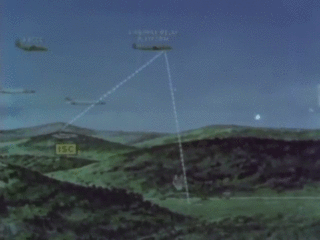The Cybernetic Jungle
About
Like many controversial conflicts during the Vietnam war, "Operation Igloo White" remains somewhat obscured to popular history. Considering its great potential as another bombastic propaganda film illustrating the ingenuity of the US military and its patriotic spirit, it is perhaps surprising that it hasn't yet been given the full Michael Bay stars 'n' stripes treatment. Then again, one probable reason why Igloo White: The Movie hasn't featured in a cineplex near you is that it is considered to be a major military controversy, and another entry on the long list of induced 'Nam amnesia.
Despite its failure, Igloo White was an important precursor to the kind of remote-controlled warfare those in Pakistan have to undergo on a weekly basis today. It set the precedent of ordinary soldiers fighting on the frontline from a computer terminal in a bunker, distant from the battlefield itself. While similar endeavors were explored during World War II and the MAD, early decades of the Cold War, Igloo White could be seen as the field test for contemporary drone warfare, and in this way only could it be deemed a worthwhile campaign.
As with the majority of US military campaigns featuring experimental technologies, the raw materials for Igloo White were developed at MIT in the late 1960s with a R&D group known as JASON. The idea was to create a network of sensors along the Ho Chi Minh Trail, a transport route of strategic importance that ran through the jungles of North Vietnam into the South, through Laos and Cambodia. A variety of sensors were used in the operation: vibration sensors to detect movement of truck convoys, microphones to pick up the speech of the enemy soldiers, and even sensors that could detect the scent of urine. [1] The sensors were mostly dispersed by air - like seedlings, designed to embed themselves in the ground and appear like small plants, or get caught in the jungle canopy disguised amongst the trees, quietly emitting data streams via radiowaves. The result was a cybernetic jungle, a natural space invaded by micro-computers broadcasting a symbolic representation of their environment.
The network was controlled and observed from a US military command center (the Infiltration Surveillance Center - ISC) hundreds of kilometers to the North West in Nakhom Phanom, Thailand. Soldiers would turn up for work in a windowless bunker in full uniform, watching over the network for unusual patterns in the incoming data that might suggest suspicious activity. By analysing the data collected from a number of sensors proximate to one another, the size of a convoy could be ascertained, and perhaps what type of vehicles are being used. The soldier could then order an air strike of the area:
- "The planes' navigation systems and computers automatically guided them to the "box", or map grid square, to be attacked. The ISC central computers were also able to control the release of bombs: the pilot might do no more than sit and watch as the invisible jungle below suddenly exploded into flames. In most cases, no American ever actually saw the target at all."[1]
Through this remote system, the enemy is replaced by symbols that represent the enemy: flows of numbers, or a glowing white light on a computer monitor. The only sensor that apparently managed a direct representation of the enemy was the microphone, relaying the voices and sounds back to the ISC where it could be recorded to tape for later analysis. But indeed, by abstracting the human-enemy into a continual data stream, a paranoid curiosity can begin to take over: how do I know this symbol signifies the actual presence of the enemy? Is it a glitch? Is the enemy playing tricks on me?
At a cost of about one billion US dollars per year to operate, Operation Igloo White was hardly an incidental military investment. The expected return was control over the regional logistics, and to further the policy of containment. Operation Igloo White was declared a great success by the US, but in truth the figures detailing the cost of destruction to the Vietcong were greatly inflated. The amount of airstrikes triggered and delivered by the network may have indicated a victory, but through further analysis of the statistics did not make sense. The curious paranoiac would have been right to become anxious: the Vietnamese soldiers began to learn and adapt to the cybernetic jungle, using the assumption that the sensors broadcast an objective truth to their advantage:
- "The guerillas had simply learned to confuse the American sensors with tape-recorded truck noises, bags of urine, and other decoys, provoking the release of countless tons of bombs onto empty jungle corrdoes, which they then traversed at their leisure." [1]

